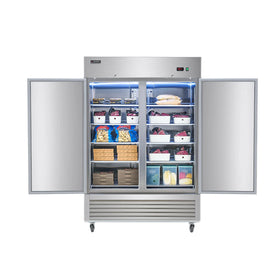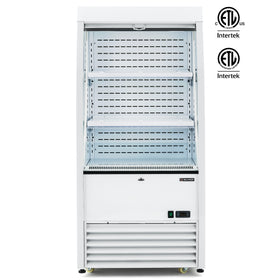When a fridge keeps freezing everything, one of two problems has likely occurred:
- The fridge is cooling more than it should
- Cold air isn’t circulating the way it’s supposed to.
The good news is that both of these problems are quite common in both household and commercial fridges, and are relatively easy to identify: all it takes is a few checks. Also, in some cases, you can solve the problem yourself.
Let’s go through why your fridge is freezing everything, why it's happening, and what you can do about it. The tips in this blog will work for both a regular household refrigerator and a larger commercial refrigerator unit.
Fridge is Freezing Everything: Top 6 Reasons
1. The Temperature Is Set Too Low
If your fridge is freezing everything, the thermostat is likely set below the recommended 37–40°F (3–4°C). At lower temperatures, the fridge will keep running colder than necessary. Eventually, the food will freeze.
Consider this:
- Perhaps someone accidentally set the fridge colder
- Someone may have adjusted the dial, thinking it would make things chill faster.
To resolve this problem, check the settings and adjust if needed. Then give it 24 hours to stabilize, and you should be good to go.
2. The Sensor is Faulty
If your fridge is freezing everything, and the freezing is not limited to a particular spot, it is likely because of a faulty thermistor.
- Most modern fridges use sensors (technically called thermistors) to measure the internal temperature.
- When the sensor fails, the control system doesn’t know when to stop cooling.
- This will eventually lead to the entire compartment being frozen.
In the case of a faulty thermistor, you have to call a technician. Replacing a thermistor must be a job for a professional technician. This may cost about $50-$200, depending on where you live.
3. A Damper is Stuck Open
If your fridge is freezing everything, and you notice that the items close to the vent are freezing first, it is likely because a damper is stuck open.
- The damper is a small flap that controls how much cold air enters from the freezer.
- When it gets stuck open, too much cold air rushes into the fridge, and everything begins to freeze, starting from the items closest to the damper.
To solve this issue, defrosting sometimes works (it clears the blockage), but if the damper motor is broken, it will need repair or replacement.
4. Air Ducts are Blocked or Frozen
When your fridge is freezing everything, and you notice that the items at the bottom are freezing first, it is likely because the air ducts are blocked or frozen.
- The ducts and vents allow cold air to circulate between the freezer and fridge
- If those vents get blocked by food, ice, or frost, cold air pools instead of moving evenly, it stays in the fridge compartment.
- This is why food at the bottom freezes first.
To solve this problem, make sure the vents are not blocked (usually they are blocked by containers). If you see frost or ice, a defrost cycle may be necessary.
5. A Door Seal is Worn
The rubber gasket around the fridge door is meant to keep warm, humid room air out, and if it is compromised in any way, you will notice the fridge beginning to freeze. Here’s how it happens:
- When the door seal is cracked, loose, or dirty, warm outside air leaks into the fridge.
- That moisture will then turn into frost around the vents and disrupt circulation, eventually causing freezing.
You can solve this by testing the seal by closing a piece of paper in the door. If it slips out easily, the seal needs to be replaced.
6. The Defrost System Has a Problem
If your fridge has missed a defrost cycle, it might eventually start freezing everything. Most modern refrigerators come with automatic defrost features that defrost their coils at regular intervals.
- If the defrost heater, timer, or control board fails, frost keeps building up.
- Eventually, the vents clog, and cold air no longer circulates properly- freezing some items while leaving others warm.
Manually defrosting may bring temporary relief, but if the issue keeps returning, a technician will need to repair the defrost system.
Why Fridges Start Freezing Everything: The Theory
The first step to figuring out why your fridge is freezing everything (and what to do about it) is to understand the basics of how a refrigerator works.
- A refrigerator typically does not cool the refrigerator compartment directly. Usually, the freezer is cooled first, then the cold air is distributed into the fresh food section.
- Now, that cold air must be able to flow in and out of the fresh food section freely, else it will settle, collect, and start freezing everything.
- This explains why many people first notice that vegetables in the lower drawers are frozen, and the items on the upper shelves seem okay.
The reason is that the cold air is being blocked from returning to the freezer and has settled at the bottom of the fridge, freezing everything.
The opposite happens when it is not an airflow problem and the controls fail. The system just keeps cooling nonstop, and everything gets frozen regardless of airflow.
Fridge Freezing Everything: Air Flow Issues vs. Control Problems
| Category | Cause | Signs You’ll Notice | What to Do |
| Airflow Issues | Return vent is blocked or frozen | Frost around vents, food freezing from the bottom | Clear food blocking vents; defrost if iced over |
| A damper is stuck open | Items near the vent freeze quickly | Inspect the vent area and consider replacing the damper if it doesn’t move | |
| Defrost failure leads to frost buildup | Cooling is uneven, frost inside the fridge, and freezing in some spots | Conduct a full manual defrost. If the issue returns, repair defrost heater/timer/control | |
| The door seal is worn or leaky | Frost/ice accumulated near ducts, condensation, and uneven temperatures | Clean the gasket. Replace it if cracked, warped, or loose | |
| The evaporator fan is not working | Some areas are too cold, others are too warm | Listen for fan noise; replace the fan if it's silent/broken | |
| Control Problems | The thermostat is set too low | The whole fridge is too cold | Reset to 37–40°F (3–4°C) and wait 24 hrs |
| The thermistor is faulty | The entire compartment is frozen over | This requires sensor replacement | |
| The control board has failed | The fridge runs nonstop, and everything freezes | Professional replacement is needed | |
| Faulty thermostat (mechanical models) | Constant overcooling | Replace thermostat |
Frige Freezing Everything: The Easy At-Home Test
If you want to troubleshoot on your own, there’s a simple way to check whether frost buildup is the problem:
- Unplug the fridge or turn it off at the breaker.
- Leave the doors open for 24 hours to let all frost and ice melt.
- Place towels in the freezer to catch the water.
- Plug the fridge back in and see how it runs.
If the problem is gone and never comes back, it was likely just a temporary frost issue. If it returns in a week or two, the defrost system, door seals, or airflow system may be at fault. At that point, it’s time to call a technician.

Fridge Freezing Everything: Household vs. Commercial Fridges
Both household fridges and commercial refrigerators rely on the same basic systems, but issues can appear differently.
- In household fridges, the most common problems are user settings, blocked vents, and worn door gaskets.
- In commercial fridges, specifically reach-in refrigerators, which are opened more frequently and hold heavier loads, airflow restrictions and defrost system failures are more common.
The troubleshooting steps are the same, but commercial units are usually more complex and benefit from professional servicing sooner.
When to Call a Technician
If the freezing continues, fans stop running, frost returns quickly, or the fridge seems to ignore its temperature settings, then professional repair is the only way forward.
Final Thoughts
When your fridge starts freezing everything, it is not necessarily broken beyond repair - it’s usually a matter of too much cold air or poor airflow. Sometimes the fix is as simple as adjusting the temperature or replacing a worn gasket.
Other times, the problem lies deeper in the defrost system, sensors, or fans. The only way you would truly know is by understanding the likely causes and trying the safe checks first. This way, you can save time, prevent food loss, and determine if it’s time to bring in a professional.
Consider our guide on when to clean and service a commercial refrigerator.












